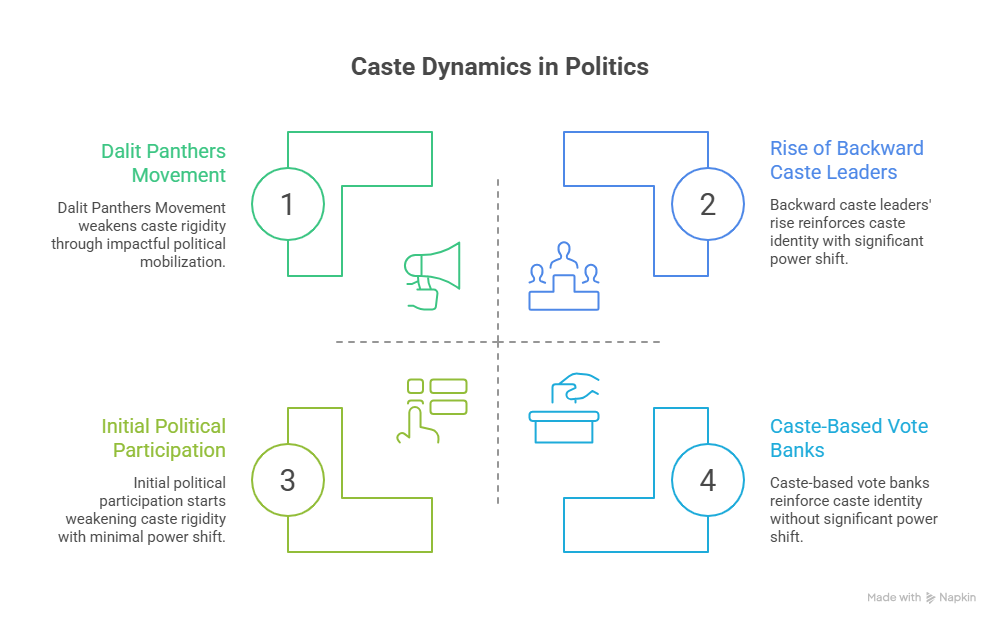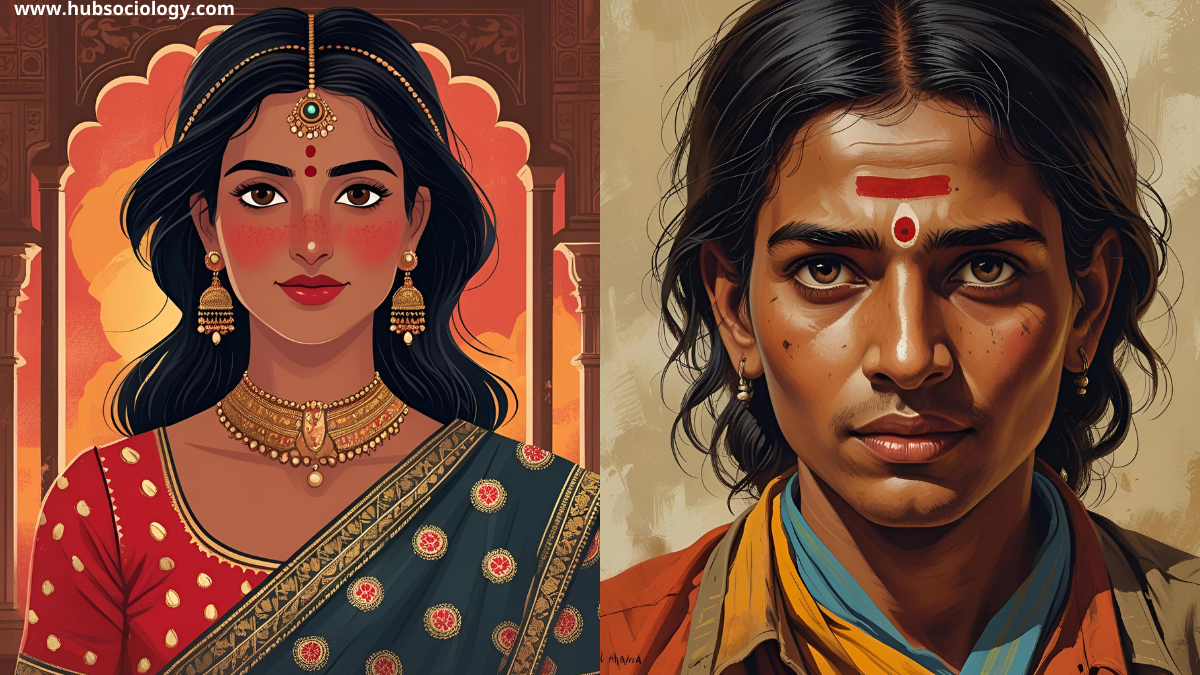Introduction on Caste and Politics
Caste and politics in India are deeply interlinked phenomena that have shaped the country’s democratic processes, electoral outcomes, and patterns of governance. While caste is a traditional system of social stratification rooted in hierarchy, politics in a democracy seeks to represent people through equality and participation. At first glance, these two appear contradictory—caste emphasizes inequality and hereditary status, while democracy emphasizes equality and mobility. However, in practice, caste has played a central role in shaping Indian politics, and politics has in turn transformed caste relations. A sociological understanding of this interplay reveals how social structures and political institutions influence each other in complex ways.
The Sociological Roots of Caste in Politics
Caste in India historically functioned as an institution regulating social life, marriage alliances, occupation, and community solidarity. It was not only a system of hierarchy but also a system of identity and belonging. With the advent of modern democratic politics, caste identities did not disappear; rather, they adapted to new contexts.
From a sociological standpoint, caste serves as both a form of social capital and a mode of collective mobilization. Political parties in India often recognize caste groups as important vote banks. Caste associations, once primarily cultural, have transformed into political lobbies, demanding representation, reservations, and resources for their members.
The works of sociologists like M. N. Srinivas (concept of dominant caste) and Rajni Kothari (caste as a central factor in Indian politics) highlight how caste became an important determinant in the democratic process. Caste, far from declining in importance, gained a new kind of relevance in electoral politics.
Caste and Electoral Politics
Elections are the most visible arena where caste and politics intersect. Voting behavior in India is often influenced by caste loyalties. For many voters, political preference is shaped by the candidate’s caste identity and the perception of how well they will safeguard the community’s interests.
Political parties, in turn, field candidates strategically from specific caste groups to secure votes. This is evident in states like Uttar Pradesh and Bihar, where alliances are built on caste arithmetic—mobilizing Brahmins, Yadavs, Dalits, or Other Backward Classes (OBCs) in specific coalitions. Even in southern states like Tamil Nadu or Karnataka, caste-based mobilization remains significant.

Sociologically, this reveals how traditional solidarities are reconfigured in the modern public sphere. Caste is not just a matter of ritual purity or hierarchy anymore but has become a resource for collective bargaining in the democratic system.
Caste and Political Representation
One of the central issues in the relationship between caste and politics is the demand for representation. Historically, Dalits and other marginalized groups were excluded from positions of power. The Indian Constitution introduced reservations in legislatures, education, and public employment to ensure inclusivity.
This affirmative action has had transformative sociological consequences. It enabled marginalized groups to develop leadership, gain visibility, and articulate their grievances. Leaders like B. R. Ambedkar emphasized that without political representation, social justice would remain incomplete. Today, Dalit and backward caste leaders occupy chief ministerial positions, head political parties, and shape state and national policies.
The demand for caste-based quotas continues to shape political discourse, as seen in movements for OBC reservations, the Mandal Commission debates of the 1990s, and more recent agitations by communities like Patidars in Gujarat or Marathas in Maharashtra. These movements reveal how caste remains a powerful mobilizing factor in democratic struggles for equality.
Caste and Political Parties
Most Indian political parties are compelled to consider caste while formulating strategies. Some parties are explicitly caste-based, such as the Bahujan Samaj Party (BSP), which emerged to represent Dalit interests under Kanshi Ram and Mayawati. Others, like the Samajwadi Party (SP) or the Rashtriya Janata Dal (RJD), gained strength by mobilizing backward castes.
Even national parties like the Indian National Congress and the Bharatiya Janata Party (BJP) cannot ignore caste dynamics. The Congress traditionally followed a strategy of balancing upper castes, Muslims, and Dalits, while the BJP has recently expanded its reach by mobilizing non-dominant OBCs and Dalits alongside its traditional upper-caste base.
From a sociological lens, this demonstrates how caste has become a political resource that parties use to create broad social coalitions. Politics, in turn, alters caste by creating new alliances and redefining boundaries of inclusion and exclusion.
Caste, Social Justice and Political Power
The role of caste in politics is not only about vote banks but also about social justice. For centuries, lower castes faced exclusion, humiliation, and exploitation. Political participation has provided them with a platform to demand dignity, rights, and redistribution of resources.
Movements like the Dalit Panthers in Maharashtra, inspired by Ambedkarite ideology, show how caste-based mobilization can challenge entrenched hierarchies. Similarly, the rise of backward caste leaders like Lalu Prasad Yadav in Bihar or K. Kamaraj in Tamil Nadu reflects the shift of power from elite upper castes to historically marginalized groups.
From a sociological standpoint, this represents a process of political democratization of caste. Politics has weakened the rigidity of caste by enabling upward mobility and creating spaces for negotiation. At the same time, it has also reinforced caste identities by making them the basis of political claims.

Caste and Developmental Politics
In recent decades, Indian politics has seen a shift from purely caste-based mobilization to developmental politics. Parties now combine appeals to caste with promises of development, welfare schemes, and infrastructure. However, caste continues to shape the distribution of welfare benefits. Many welfare schemes are targeted at specific caste categories (Scheduled Castes, Scheduled Tribes, OBCs).
For example, mid-day meal schemes, scholarships, or skill development programs are often framed in terms of caste-based beneficiaries. This indicates how the state institutionalizes caste categories even as it seeks to promote equality.
Criticism and Challenges on Caste and Politics
The intertwining of caste and politics has both positive and negative sociological consequences.
Positive aspects include:
- Empowerment of marginalized communities.
- Breaking of monopoly of upper castes in politics.
- Expansion of democratic participation.
Negative aspects include:
- Fragmentation of society into caste-based vote banks.
- Reinforcement of caste identities rather than their erosion.
- Emergence of competitive populism and caste rivalries.
Thus, while caste in politics has democratized power, it has also prevented the formation of broader class-based or issue-based politics.
The Changing Nature of Caste in Politics
Sociologists argue that caste in politics today is undergoing transformation. Urbanization, migration, education, and economic change have weakened some traditional aspects of caste. Yet caste identities have not disappeared; rather, they have acquired new forms.
For instance, in cities, caste may not dictate occupation or neighborhood as strongly, but it may still influence matrimonial choices or political loyalties. The younger generation often negotiates caste in hybrid ways—asserting it for political representation but downplaying it in professional spaces.
In the long run, caste in politics may evolve from rigid identity politics to more flexible forms of coalition building, where caste interacts with class, gender, and regional factors.
Conclusion on Caste and Politics
Caste and politics in India form a complex and paradoxical relationship. While caste is rooted in hierarchy and exclusion, politics in a democracy is based on equality and participation. Yet, instead of eliminating caste, politics has restructured it, turning it into a vehicle of empowerment, representation, and mobilization.
From a sociological perspective, the interaction of caste and politics reflects both continuity and change—continuity in the persistence of caste identities, and change in the way they are expressed and negotiated within democratic frameworks. The challenge for Indian society lies in moving towards a political culture that values justice and equality while transcending narrow caste divisions.
In this sense, caste in politics is not merely a problem but also an opportunity—an opportunity to transform traditional hierarchies into new forms of democratic participation and to use identity as a means of inclusion rather than exclusion.
Exam-style questions on Caste and Politics
5 Marks Questions on Caste and Politics
- Define the relationship between caste and politics in India.
- What is the concept of “dominant caste” as given by M. N. Srinivas?
- How does caste influence voting behavior in India?
- Mention two positive effects of caste politics in India.
- Who was B. R. Ambedkar, and what role did he play in linking caste and politics?
10 Marks Questions on Caste and Politics
- Explain the role of caste in Indian electoral politics with suitable examples.
- Discuss the sociological importance of caste-based political mobilization.
- How do political parties in India use caste as a tool of social coalition?
- Explain the impact of caste-based reservations on political representation in India.
- Critically analyze the role of caste politics in promoting social justice.
15 Marks Questions on Caste and Politics
- “Caste and politics in India are contradictory yet complementary.” Discuss with sociological arguments.
- Examine how caste has shaped the rise of regional political parties in India.
- Analyze the role of caste politics in the democratization of Indian society.
- How has globalization, urbanization, and modernization transformed the caste–politics relationship in India?
- Critically evaluate the positive and negative consequences of caste politics in shaping Indian democracy.
